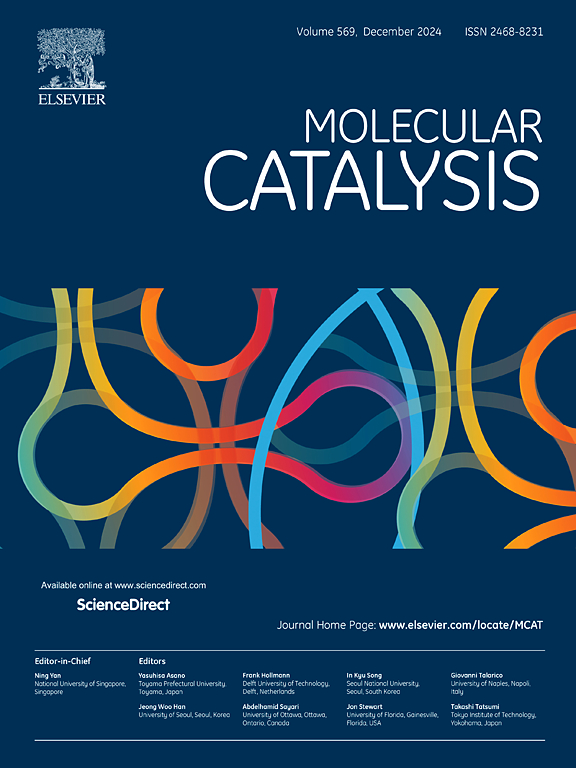Upgrading the performance of syngas to ethanol via Mn modified Rh-based catalyst
IF 3.9
2区 化学
Q2 CHEMISTRY, PHYSICAL
引用次数: 0
Abstract
Significant strides have been undertaken to catalyze the production of ethanol from syngas, yet the challenge remains in developing catalysts that simultaneously exhibit high activity and selectivity. In this study, we designed a high-performance Rh-Mn catalyst. The CO conversion of finally screened 1Rh1Mn/TiO2 catalyst is 51.8 %, and the total alcohol selectivity and ethanol yield are 72.1 % and 24.1 % respectively. This is the highest ethanol yield reported to date for Rh-based catalysts. Additionally, this catalyst also kept good stability. The outstanding performance is attributed to the fact that Mn facilitates the formation of Rh+ active sites, the process of CO insertion, and the generation of CH3CHO and CH3CO species—critical intermediates in ethanol production. In contrast, the unpromoted 1Rh/TiO2 catalyst showed poor ethanol selectivity and mainly produced the Rh0 species, whereas the 1Rh1Mn/TiO2 catalyst with the addition of Mn showed an increase in total alcohol and ethanol selectivity of 26.5 % and 31.3 %, respectively, as well as a reduction in CO2 of 50.4 %. In addition, we elucidated the CO2 generation and conversion pathways in the syngas to ethanol process, which is important for the effective utilization of carbon resources.

通过锰改性铑基催化剂提升合成气制乙醇的性能
催化合成气生产乙醇的研究取得了重大进展,但在开发同时具有高活性和高选择性的催化剂方面仍然存在挑战。在本研究中,我们设计了一种高性能的 Rh-Mn 催化剂。最终筛选出的 1Rh1Mn/TiO2 催化剂的 CO 转化率为 51.8%,总醇选择性和乙醇产率分别为 72.1% 和 24.1%。这是迄今为止报告的含 Rh 催化剂的最高乙醇产率。此外,这种催化剂还保持了良好的稳定性。之所以能取得如此优异的性能,是因为 Mn 促进了 Rh+ 活性位点的形成、CO 插入过程以及 CH3CHO 和 CH3CO 物种的生成--这些都是乙醇生产过程中的关键中间产物。相比之下,未经促进的 1Rh/TiO2 催化剂的乙醇选择性较差,且主要产生 Rh0 物种,而添加了锰的 1Rh1Mn/TiO2 催化剂的总醇和乙醇选择性分别提高了 26.5% 和 31.3%,二氧化碳减少了 50.4%。此外,我们还阐明了合成气制乙醇过程中二氧化碳的生成和转化途径,这对于有效利用碳资源非常重要。
本文章由计算机程序翻译,如有差异,请以英文原文为准。
求助全文
约1分钟内获得全文
求助全文
来源期刊

Molecular Catalysis
Chemical Engineering-Process Chemistry and Technology
CiteScore
6.90
自引率
10.90%
发文量
700
审稿时长
40 days
期刊介绍:
Molecular Catalysis publishes full papers that are original, rigorous, and scholarly contributions examining the molecular and atomic aspects of catalytic activation and reaction mechanisms. The fields covered are:
Heterogeneous catalysis including immobilized molecular catalysts
Homogeneous catalysis including organocatalysis, organometallic catalysis and biocatalysis
Photo- and electrochemistry
Theoretical aspects of catalysis analyzed by computational methods
 求助内容:
求助内容: 应助结果提醒方式:
应助结果提醒方式:


